Top News

January 10, 2013 Ryukyu Shimpo
The Ogimi Municipal Office has established a special committee to support the rebuilding of the monument honoring Miyagi Shinsho in Ishinomaki, Miyagi Prefecture. The late Shinsho Miyagi (1884-1967), who was from the Arime district of Ogimi, was referred to in Miyagi Prefecture as the father of the cultured oyster. The monument was destroyed by the tsunami caused by the Great East Japan Earthquake, and the Ogimi Municipal Office will do all it can to support the reconstruction of the monument.
Known as a “father of the cultivated oyster,” or the “king of oysters,” after Miyagi graduated from Kunigami Agricultural High School, he went to North America to study the cultivation of oysters. After his return to Japan, together with his family, he opened a large-scale oyster farm on the Oginohama coast, as well as at Mangoku-ura in Ishinomaki. He developed what is termed the hanging-method, a culturing technique by which oysters are threaded together on ropes, and succeeded in rapidly increasing production.

Shinjo Miyagi
In 1979 a monument to honor his work was erected at Oginohama Port in Ishinomaki, but this was knocked over by the tsunami following the Great East Japan Earthquake, and was later discovered broken in half in July 2011.
Secretary-general of the Fisheries Cooperative Association in Miyagi Prefecture, Shinji Fushimi, put together a committee to deal with the restoration of the monument, thinking that preserving the broken monument would serve as a symbol for reconstruction. “We also lost houses and ships and are still in the process of recovery. We set up this committee so we can take another step in that process,” Fushimi commented. Kenryu Miyagi, Miyagi’s relative who has lived in Miyagi Prefecture and is now head of Nerome Ward in Ogimi, called for the people of Ogimi to support the project. In response, a special committee led by Ogimi Mayor Yoshihisa Shimabukuro was established in December last year to commemorate Miyagi’s work and to promote the restoration of the monument. kiyoomi Yamashiro, the deputy mayor of Ogimi, commented, “We cannot force people in Miyagi Prefecture to bear the burden of this. We want to support this project.”

The monument honoring Shinjo Miyagi - the father of cultured oysters, before the disaster.
The committee aims to raise 5000000 yen and to start the construction from September this year. On January 19 and 20, a panel discussion led by Asako Kishi, the second daughter of Miyagi and a food and life journalist, will be held at the Ogimi Industrial Festival. They hope to expand activities from there.
For more information on making a donation, please contact Motoko Inafuku at the head office on 080 6494 8220.
(Photographs provided by the special committee in Ogimi)
(English translation by T&CT, Kyoko Tadaoka and Mark Ealey)
Go to Japanese
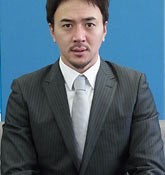
December 31, 2012 Ryukyu Shimpo
On December 28, Akihito Yagi, the chairman of the International Meibukan Gojyu-Ryu Karate-Do Association, visited the Ryukyu Shimpo Office in Ameku, Naha. Yagi reported that on his trip he taught and promoted Okinawan karate in about ten countries in North America and Europe. He said that by promoting authentic Okinawan karate to the world, he wants to uphold the traditions that he has inherited from his masters. From June to December 2012, Yagi traveled around his various overseas dojo. Training students ranging from beginner children to black belt holders, he offered special classes at local schools and appeared on television to promote Okinawan culture. “I want to uphold the traditions of karate, which is part of the cultural legacy that we should be proud of, and pass them on to the next generation,” said Yagi.
(English translation by T&CT, Lima Tokumori and Mark Ealey)
Go to Japanese
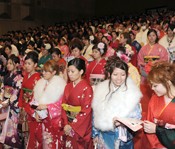
January 14, 2013 Ryukyu Shimpo
On January 13, the day before Coming-of-Age Day, a Japanese national holiday held annually on the second Monday of January, ceremonies were held in 20 cities and towns, including Naha, Okinawa, Uruma, Urasoe, Ginowan, and Nago. Young people dressed in suits and traditional kimonos attended the ceremonies from which they stepped out as adults.
The Okinawa Municipal Office held a ceremony in the city hall and celebrated 1685 young people newly becoming adults. Student of the Okinawa Christian Junior College Ayane Takaesu stated in her speech, “I am happy and proud, but am also mindful of the responsibility that comes with becoming an adult. As civic-minded adults, let’s strive to create a bright future.”
Mayor Mitsuko Tomon said, “You may not know what to do when you encounter unknown situations, but you have youth and passion so you can make your dreams and hopes come true. If you do your best, you can make things happen. I hope that you take up the challenges ahead of you.” According to the Okinawa Prefectural Office, 17323 people became new adults, 203 fewer than last year.
(English translation by T&CT, Megumi Chibana and Mark Ealey)
Go to Japanese

Go To Video
January 12, 2013 Ryukyu Shimpo
On January 11, at a press conference held at the Okinawa Prefectural Office, a senior staff member of the Naha Plant Protection Station announced that the serious plant pest known as the sweet potato weevil, or Cylas formicarius, has been eradicated on Kume-jima. The Naha Plant Protection Office of the Ministry of Agriculture, Forestry and Fisheries has been carrying out a survey of the extermination of the weevil on Kume-jima since June 2012. This is the first case in the world in which a coleopteran pest (beetle) has been eradicated by releasing into their population a large number of insects that have been sterilized through exposure to radiation. The eradication took more than 18 years to achieve. After revising relevant regulations, the Ministry of Agriculture, Forestry and Fisheries will officially announce the successful eradication of the sweet potato weevil on Kume-jima before the end of March at the earliest.
The Naha Plant Protection Station completed the survey on December 28, 2012, but then last September confirmed the presence of weevil originating from sweet potatoes brought from the Okinawan mainland, so they extended the term of the survey. No further occurrence of weevils was subsequently confirmed, so the station brought the survey to an end.
In keeping with the Plant Protection Act, after it submits the safety report to its Food Safety and Consumer Affairs Bureau, the Ministry will hold public hearings run by academics, and then call for public comments. The government will then remove restrictions on the movement of sweet potatoes from Kume-jima.
Because another type of serious plant pest weevil still remains on Kume-jima, people are still unable to take host plants there, and are also prohibited from shipping sweet potatoes such as beniimo to other prefectures without having undergone heat treatment. Even so, a local farmer said, “This will make it easier for us to grow sweet potatoes.” Local potato farmers hope to expand shipments to the mainland of Okinawa.
Akio Toguchi, a senior staff member of the Naha Plant Protection Station, commented, “We have been working since 1994 to eradicate the weevil, and are proud of this achievement. It is a world-first. We would like to cooperate with residents of Kume-jima in order to prevent the reappearance of the weevil.”
(English translation by T&CT, Mark Ealey)
Glossary
Sterile insect release method
A method used to eradicate serious plant pests. Large numbers of insects sterilized through exposure to radiation are released to mate in the wild and thereby contribute to the eradication of the population of that insect. In Okinawa, melon fly was eradicated using this method in 1993, but this is a world-first for the eradication of a type of beetle.
Go to Japanese
January 19, 2013 Ryukyu Shimpo
On January 18, the Development Bank of Japan (DBJ) released an interim report from a survey of tourists from eight locations in Asia. In general, many of them would like to travel on what is often termed the “Golden Route,” the route between Tokyo and Osaka, and then travel on to Hokkaido. Okinawa was mainly popular with tourists from China, Hong Kong and Taiwan. A recognition survey carried out with Taiwanese and Hong Kong tourists indicated that Okinawa was one of the five most attractive destinations for those who have never been to Japan, along with Tokyo and other parts of Japan. At the same time, Okinawa ranked fourth as the
Japanese tourist spot that Hong Kong tourists would like to visit in future.
The DBJ surveyed people in eight locations including Beijing, Shanghai and Thailand, Malaysia and Indonesia. It will submit suggestions for each region of Japan for attracting tourists on a sustainable basis.
The recognition survey for tourists who had never been to Japan (multiple answers allowed), revealed that 77 percent of Taiwanese tourists answered that they knew of Okinawa. The Prefecture was one of the most popular locations, following Hokkaido with 84 percent, and Tokyo and Mount Fuji with 79 percent. The survey revealed that 61 percent of the Hong Kong tourists knew Okinawa. The number followed those for Hokkaido, Tokyo and Mount Fuji, Osaka. Fifty-six percent of Beijing and Shanghai tourists knew Okinawa along with 45 percent of Korean, 40 of Thai and 39 of Malaysian, 33 of Indonesian. The survey of tourists who have been to Japan previously, revealed that Okinawa came in tenth on the list of the most popular tourist destinations for people in Beijing, Shanghai, Taiwan, Malaysia and Indonesia.
The survey revealed that 29 percent of Hong Kong tourists surveyed who have not visited Japan, responded to the effect that they would like to travel to Okinawa, with Okinawa coming fourth on the list of most popular tourist destinations for them, following Tokyo which recorded 42 percent, Hokkaido with 46 percent and other regions. Twenty-four percent of the Hong Kong tourists, who have visited Japan (once), answered that they would like to visit Okinawa, and Okinawa came in fifth on the list. At the same time, 36 percent of Taiwanese tourists surveyed who had not visited Japan answered that they like to visit Okinawa in future. Okinawa did not measure up to Hokkaido with 66 percent, or Tokyo and Osaka which both registered 45 percent, despite having a high profile among Taiwanese tourists. While the numbers of respondents from Korea, Beijing and Shanghai who have never visited Japan were low, 12 percent of Korean tourists and 27 percent of those from Beijing and Shanghai answered that they would like to visit Okinawa.
The DBJ surveyed a total of 4000 tourists, including 500 male and female respondents aged between 20 to 59 years old from eight Asian locations who responded to an Internet survey at the end of October of 2012. Half of the Korean and Beijing tourists surveyed had never visited Japan. Seventy percent of the Thai tourists and more than 80 percent of the Malaysian and Indonesian tourists surveyed had never been to Japan.
(English translation by T&CT, Mark Ealey)
Go to Japanese
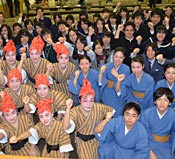
January 16, 2013 Ryukyu Shimpo
The Okinawa Prefecture Board of Education has launched a project to send high school students engaged in arts and cultural activities to Singapore in February, and then to Shanghai in March, in order to deepen cultural exchanges with young people in those cities. On January 15, the board held a send-off ceremony in the Okinawa Prefectural Government offices, in which the students who will participate in the project performed the acts that they will perform overseas.
The board has selected a total of 73 students on this occasion.
In the ceremony, Saya Shiroma of Naha High School, who will be part of the Japanese Calligraphy Division going to Shanghai, said, “I want to represent Okinawa as best I can and to tell them about the attractions of Okinawan culture. I want to encourage friendly relations between Japan and China.” Hiroshi Oshiro, the head of the board, said, “I want the students to learn from other countries’ cultures and to become more internationally-minded.”
At the ceremony, students belonging to the Music Division played the saxophone and others of the Local Performing Arts group performed the Ryukyuan dance Yotsudake.
(English translation by T&CT, Mark Ealey)
Go to Japanese
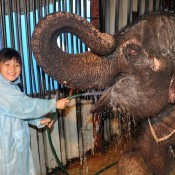
January 13, 2013 Ryukyu Shimpo
On January 12, a special “Take Care of an Elephant” event was held at the Kinoshita Circus venue at Toyosaki in Tomigusuku. Nagi Oshiro, a third-grade pupil of Takara Elementary School, enjoyed the hands-on learning opportunity, washing down an elephant and helping to clean out its enclosure.
“The elephant was bigger than I thought, but it’s really cute,” she said.
Her job started from 7:30am, so she got up early to get ready to help look after the elephants. Nagi likes animals and dreams of becoming a vet in future. Standing on its front legs as the elephant sat down, she brushed its head and trunk clean with water and a hose. The animal raised its trunk high into the air as though totally satisfied with proceedings. Not concerned about the large amount of droppings, she said, “That doesn’t worry me at all. It doesn’t smell as bad as my three year-old sister’s.” The trainers smiled as they watched her get stuck into her work.
(English translation by T&CT, Mark Ealey)
Go to Japanese
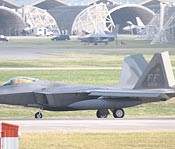
January 15, 2013 Ryukyu Shimpo
On January 14, nine U.S. F-22 Raptor stealth fighters flew in to Kadena Air Base. The U.S. Air Force plans to deploy a total of twelve of these aircraft to Kadena within the next four months, with the remaining three aircraft coming on January 15.
Local citizens opposed the deployment, saying that it will mean even worse levels of noise.
The F-22 is the latest type of fighter, using stealth technology to make it less detectable by radar or sonar. The nine aircraft that flew to Kadena Air Base belong to the Joint Base Langley-Eustis. The fighters came in from the western side of Okinawa accompanied by two KC-10 Extender aircraft and landed on the northern runway between 3:53pm and 4:30pm.
On January 11, the U.S. military announced that they would deploy a total of 300 personnel to Kadena from the 1st Regimental Combat Team of Langley Air Force Base and the 192d Fighter Wing of the Virginia Air National Guard. This is the seventh occasion that the U.S. military has deployed F-22 aircraft to Kadena Air
Base since 2007 when the aircraft were first deployed.
The U.S. Air Force had temporarily grounded the F-22 fleet after several incidents of pilots complaining of hypoxia-like symptoms, and several crashes occurring. The U.S. military stated that they have resolved safety issues by improving the on-board oxygen generating system, and resumed F-22 flying operations. These aircraft were deployed to Kadena Air Base for three months from last July.
(English translation by T&CT, Mark Ealey)
Go to Japanese
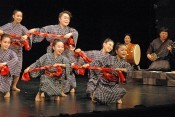
January 6, 2013 Ryukyu Shimpo
On January 5 and 6, an Okinawa Prefectural Government (OPG) sponsored tour for travel agents and media from outside Okinawa was held to look into the possibility of commercializing Okinawan performing arts. This is a part of the OPG’s cultural tourism promotion project. At the National Theatre Okinawa, young directors created a stage production that mixes Ryukyuan dance, eisa and karate, thereby promoting the potential of Okinawan performing arts.
A total of 160 participants gathered on the first day, including 24 travel agents from Tokyo and the Kansai area, and 136 people from Okinawa. The stage program included Bon Voyage! directed by Megumi Tomita, Kariyushi・Kariyushi—Shisa in Love directed by Michihiko Kakazu, and Ryukyu Gensou Emaki—Glorious RYUKYU “Haru ya haru” directed by Kazuyuki Nashiro.
The survey was carried out by asking the participants to comment both on the good points and the areas requiring improvement, as well as other criteria, such as the entrance fee and length of performance. A three-level evaluation was also conducted.
Hiroyuki Nishida, the market development team advisor for the Nippon Travel Agency said, “I couldn’t understand the local dialect. It is difficult to appreciate it without some background knowledge. It needs some additional commentary. But even so, it does have potential to be part of a school trip program or an optional tour for the elderly.” Tsuyoshi Masuda, the editor of Shunkan Ryoko Shinbun, commented, “We are planning to do an article covering the entire project. Cultural tourism has got great potential, and it’s good to offer more information on Okinawan performing arts.”
The second day of the tour program included a visit to the Kukuru Kanade Theater at the Taiken Oukoku Murasaki Mura in Yomitan, a model project for cultural tourism, which is run in collaboration with the local communities, followed by attending a production at the National Theatre Okinawa directed by Tatsuya Yasuda, Tadatoshi Teruya and Shinya Kurato.
(English translation by T&CT, Kyoko Tadaoka and Mark Ealey)
Go to Japanese
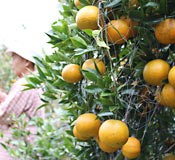
January 5, 2013 Ryukyu Shimpo
From January 5, you can enjoy picking tankan (similar to tangerines) at the Orange Farm in Izumi, Motobu Town. Due to damage caused by seawater and typhoons, the farm will be open only until the end of February this year, which is shorter than usual. On January 19 and 20, an all-you-can-grab tankan for 500-yen event, the Tankan Festival, and the Plant Fair will be held at the Izumi Tangerine Town Information Center.
There are about 20 farms where you can pick tankan. The admission is 250 yen for elementary school children and older, and 200 yen for each child in a group of children. One kilogram of tankan costs 250 yen. Tomoharu Yohena, the president of the Izumi Tangerine Production Union, said, “The taste is good as ever. I hope that people enjoy picking tankan as well as looking at the cherry-blossoms.” For more information, call Mikan-no-sato at 0980 (47) 2889.
(English translation by T&CT, Megumi Chibana and Mark Ealey)
Go to Japanese
January 7, 2013 Hideki Matsudo of the Ryukyu Shimpo reports from Washington D.C.
On January 2, the Marine Corps Times reported that the U.S. Marines have considered establishing a new jungle training facility near to continental United States. The Jungle Warfare Training Center (JWTC) is currently located in the Northern Training Area, and it is the only U.S. military facility for jungle combat training in the world.
The U.S. military has begun reviewing its costs due to financial difficulties. The aim of constructing new facilities near the American mainland is to reduce the cost of transporting troops there. If they set up a new jungle warfare facility of a similar scale as the existing JWTC, expeditionary forces to Okinawa and the frequency of operations in the Northern Training Area might decrease.
Infantry training for Marine ground forces and rescue drills in which air units participate using helicopters have been held at the JWTC. In this respect, the training center plays an important role in fostering effective joint operations for the United States Army, Marines and Air Force. Not only for the Marine Corps in Okinawa, but also for contingents from the United States that take part in the operations.
According to the Marine Corps Times, last September, the current commandant of the Marine Corps, James F. Amos, said that jungle warfare training is going to become increasingly important. He instructed that the training regime be reviewed within the next six months. This has been undertaken at the Training and Education Command (TECOM) in Virginia. Tom Murray, the commanding general of TECOM, stated that transporting large numbers of Marines to the JWTC in Okinawa is costly, so they are considering building a new facility. He said the Corps’ Mountain Warfare Training Center in Bridgeport, California, is the right model for that.
(English translation by T&CT, Lima Tokumori and Mark Ealey)
Go to Japanese











 Webcam(Kokusai Street)
Webcam(Kokusai Street)


